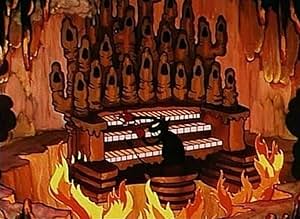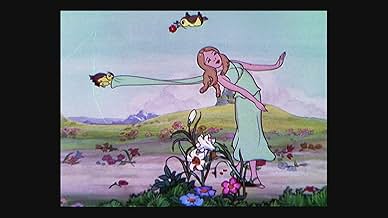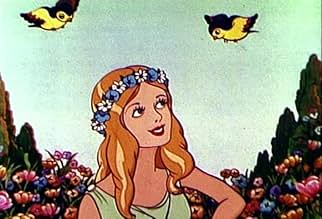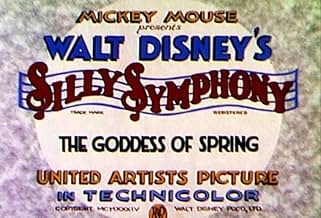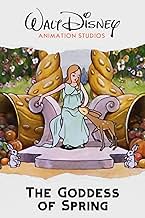IMDb-BEWERTUNG
6,6/10
1537
IHRE BEWERTUNG
Füge eine Handlung in deiner Sprache hinzuThe lovely goddess of spring, Persephone, is kidnapped by Hades, thus bringing about the winter season.The lovely goddess of spring, Persephone, is kidnapped by Hades, thus bringing about the winter season.The lovely goddess of spring, Persephone, is kidnapped by Hades, thus bringing about the winter season.
- Regie
- Drehbuch
- Hauptbesetzung
Kenny Baker
- Singing Narrator
- (Synchronisation)
- (Nicht genannt)
Jessica Dragonette
- Goddess of Spring
- (Synchronisation)
- (Nicht genannt)
Tudor Williams
- Pluto
- (Synchronisation)
- (Nicht genannt)
Empfohlene Bewertungen
As the Snow White Platinum DVD notes, The Goddess of Spring served mostly as practice for the Disney animators on how to properly animate humans for Snow White & the Seven Dwarfs. Not only did they improve on animating humans, I thought they also greatly improved on drawing backgrounds, animals, and the dwarf-like creatures that appeared in The Goddess of Spring. While The Goddess of Spring is an animated short with a much smaller budget, the difference between the dwarfs in this cartoon and Snow White are as different as night and day. The dwarfs in Goddess of Spring were all drawn the same with no unique personalities, whereas Snow White's dwarfs are all unique in both appearance and personality.
I've also read that people were impressed with how well the hell sequences were drawn in Goddess of Spring. I have to admit that I wasn't really impressed when I saw it. I thought the sequences were too bland and a little too bright for a depiction of hell. I was actually more impressed with the hell sequences drawn in 1929's Hell's Bells, one of the first, rare Silly Symphonies drawn by Ub Iwerks.
However, I will say that I did somewhat enjoy the story of Goddess of Spring, which uses mythology to explain why we don't have everlasting spring. The opera style was kind of corny though. I just didn't get the sense that Disney animators concentrated too much on this short, but rather just as practice for Snow White. Nevertheless, I guess Goddess of Spring fulfilled its mission, because Snow White is one of the greatest, most landmark films in the history of cinema.
My IMDb Rating: 5/10
I've also read that people were impressed with how well the hell sequences were drawn in Goddess of Spring. I have to admit that I wasn't really impressed when I saw it. I thought the sequences were too bland and a little too bright for a depiction of hell. I was actually more impressed with the hell sequences drawn in 1929's Hell's Bells, one of the first, rare Silly Symphonies drawn by Ub Iwerks.
However, I will say that I did somewhat enjoy the story of Goddess of Spring, which uses mythology to explain why we don't have everlasting spring. The opera style was kind of corny though. I just didn't get the sense that Disney animators concentrated too much on this short, but rather just as practice for Snow White. Nevertheless, I guess Goddess of Spring fulfilled its mission, because Snow White is one of the greatest, most landmark films in the history of cinema.
My IMDb Rating: 5/10
I can't believe I didn't see "The Goddess of Spring" before now. It is truly wonderful and unique, and I would definitely would have liked it as a kid, as I adore animation and classical music. The animation here is stunning, the upper world is so tranquil and like a paradise. Even better are the hell sequences, with dark background contrasts and a somewhat creepy atmosphere. The music is absolutely outstanding, the lyricality of the classical music of the upper world, and the sinister, perhaps even distorted Cab Calloway-inspired jazz music of hell. Then the characters, the secondary characters are sweet and endearing, not with unique personalities like the Seven Dwarfs in "Snow White" but sweet enough. Persephone is so gorgeous and pure, and Hades? In a good way he is truly diabolical, with towering presence, sinister appearance and a resonant Wagnerian-like bass voice. Overall, I loved this Silly Symphony. 10/10 Bethany Cox
For some reason the animation in this cartoon doesn't make it appear to be a Disney Silly Symphony. Still, it's a pretty good cartoon that tells the story of the goddess Persephone, kidnapped by Hades, causing Spring to prematurely turn into Winter.
It's also a rather exciting cartoon short, as well, and a clever retelling of the Greek mythology. The narration and dialog were all beautifully sung and the characters were delightful to watch.
Grade B
It's also a rather exciting cartoon short, as well, and a clever retelling of the Greek mythology. The narration and dialog were all beautifully sung and the characters were delightful to watch.
Grade B
This entry in the Silly Symphonies adapts the story of Persephone (Proserpina in Latin). "The Goddess of Spring" depicts the title character in an idealistic setting until Hades (Pluto in Latin) kidnaps her. Since she can't be happy in Hell, they have to reach a settlement.
Obviously this is a loose adaptation. As in Disney's "Hercules", Hades gets depicted as a rendering of Satan; in Greek mythology, the underworld had no relation to the modern understanding of Hell.
It's an okay cartoon. I've always been more partial to Warner Bros.'s cartoons, since they had an irreverent side (in contrast to Disney's "nice" cartoons). Jessica Dragonette (the goddess) also voiced Princess Glory in Fleischer Studios' "Gulliver's Travels". Kenny Baker (the narrator) is not to be confused with the actor who played R2D2.
Obviously this is a loose adaptation. As in Disney's "Hercules", Hades gets depicted as a rendering of Satan; in Greek mythology, the underworld had no relation to the modern understanding of Hell.
It's an okay cartoon. I've always been more partial to Warner Bros.'s cartoons, since they had an irreverent side (in contrast to Disney's "nice" cartoons). Jessica Dragonette (the goddess) also voiced Princess Glory in Fleischer Studios' "Gulliver's Travels". Kenny Baker (the narrator) is not to be confused with the actor who played R2D2.
A Walt Disney SILLY SYMPHONY Cartoon Short.
Persephone, THE GODDESS OF SPRING, is kidnapped by Hades, the devilish god of the Underworld, leaving the earth in perpetual winter. Will the warmth & joy of Spring ever return?
A vivid, and somewhat bizarre, little film which retells the story from Greek Mythology, while incorporating both operatic & jazz traditions. The animators seem to have confused the character of Hades with that of the Biblical Satan. Years later, Walt would draw comparison between Persephone & Snow White, to illustrate how far his animators evolved in just three short years.
The SILLY SYMPHONIES, which Walt Disney produced for a ten year period beginning in 1929, are among the most fascinating of all animated series. Unlike the Mickey Mouse cartoons in which action was paramount, with the Symphonies the action was made to fit the music. There was little plot in the early Symphonies, which featured lively inanimate objects and anthropomorphic plants & animals, all moving frantically to the soundtrack. Gradually, however, the Symphonies became the school where Walt's animators learned to work with color and began to experiment with plot, characterization & photographic special effects. The pages of Fable & Fairy Tale, Myth & Mother Goose were all mined to provide story lines and even Hollywood's musicals & celebrities were effectively spoofed. It was from this rich soil that Disney's feature-length animation was to spring. In 1939, with SNOW WHITE successfully behind him and PINOCCHIO & FANTASIA on the near horizon, Walt phased out the SILLY SYMPHONIES; they had run their course & served their purpose.
Persephone, THE GODDESS OF SPRING, is kidnapped by Hades, the devilish god of the Underworld, leaving the earth in perpetual winter. Will the warmth & joy of Spring ever return?
A vivid, and somewhat bizarre, little film which retells the story from Greek Mythology, while incorporating both operatic & jazz traditions. The animators seem to have confused the character of Hades with that of the Biblical Satan. Years later, Walt would draw comparison between Persephone & Snow White, to illustrate how far his animators evolved in just three short years.
The SILLY SYMPHONIES, which Walt Disney produced for a ten year period beginning in 1929, are among the most fascinating of all animated series. Unlike the Mickey Mouse cartoons in which action was paramount, with the Symphonies the action was made to fit the music. There was little plot in the early Symphonies, which featured lively inanimate objects and anthropomorphic plants & animals, all moving frantically to the soundtrack. Gradually, however, the Symphonies became the school where Walt's animators learned to work with color and began to experiment with plot, characterization & photographic special effects. The pages of Fable & Fairy Tale, Myth & Mother Goose were all mined to provide story lines and even Hollywood's musicals & celebrities were effectively spoofed. It was from this rich soil that Disney's feature-length animation was to spring. In 1939, with SNOW WHITE successfully behind him and PINOCCHIO & FANTASIA on the near horizon, Walt phased out the SILLY SYMPHONIES; they had run their course & served their purpose.
Wusstest du schon
- WissenswertesWalt Disney and his animators used this short as a test to see if they could create realistic animation, a style they would later perfect in Schneewittchen und die sieben Zwerge (1937).
- VerbindungenFeatured in Once Upon a Mouse (1981)
Top-Auswahl
Melde dich zum Bewerten an und greife auf die Watchlist für personalisierte Empfehlungen zu.
Details
- Erscheinungsdatum
- Herkunftsland
- Offizieller Standort
- Sprache
- Auch bekannt als
- A Greek Myth
- Produktionsfirma
- Weitere beteiligte Unternehmen bei IMDbPro anzeigen
- Laufzeit10 Minuten
- Seitenverhältnis
- 1.37 : 1
Zu dieser Seite beitragen
Bearbeitung vorschlagen oder fehlenden Inhalt hinzufügen

Oberste Lücke
By what name was Der Raub der Frühlingsgöttin (1934) officially released in Canada in English?
Antwort
